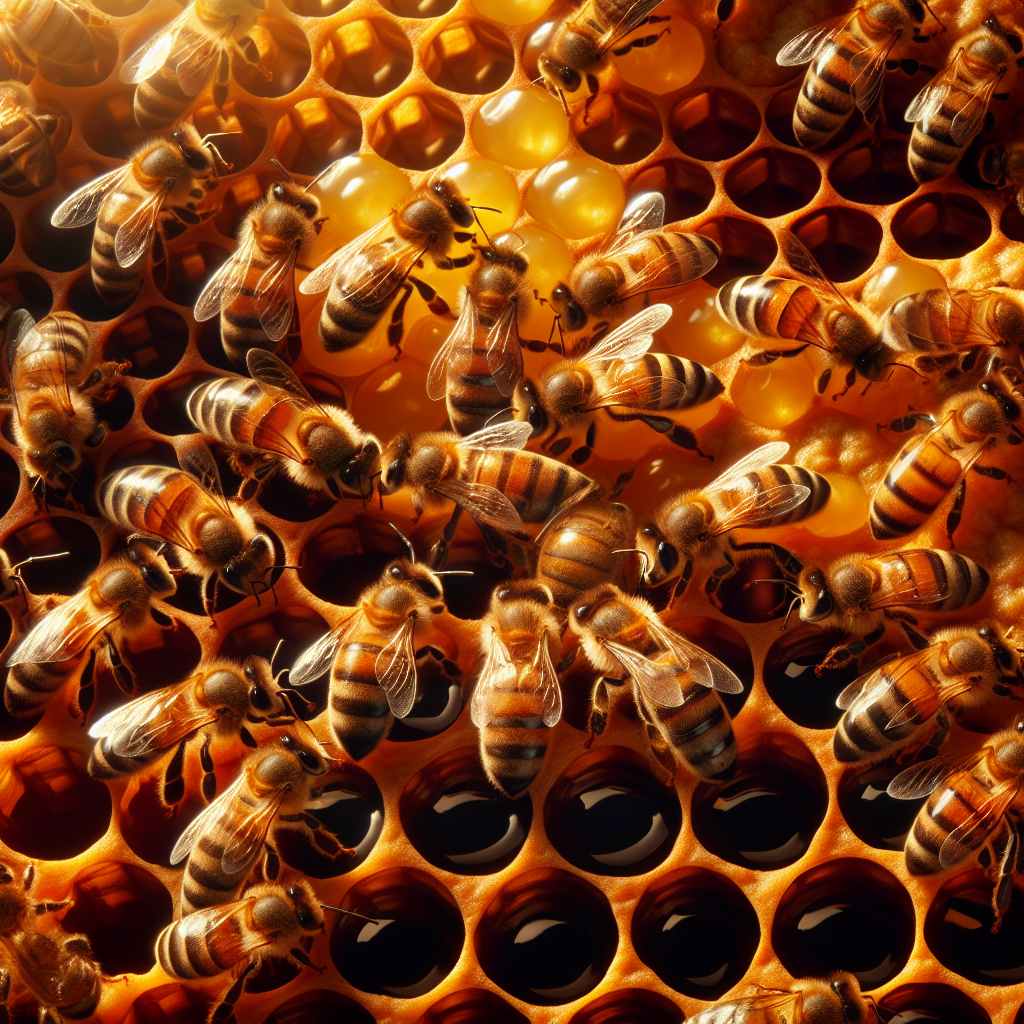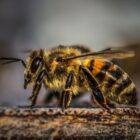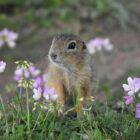Why do Honey Bees produce honey?

Honey bees, renowned for their intricate social structure and industrious nature, are often associated with the sweet golden elixir they produce: honey. But why do honey bees dedicate so much energy and effort to producing honey?
At the heart of the honeybee colony lies the queen bee, the matriarch responsible for laying eggs and maintaining the population. Surrounding her are thousands of worker bees, sterile females whose tireless efforts sustain the colony. These workers perform a multitude of tasks, from foraging for nectar and pollen to tending to the needs of the queen and her offspring.
Central to the honey-making process is the collection of nectar from flowers. Worker bees venture out from the hive in search of flowers rich in nectar, using their keen sense of smell and sophisticated communication to guide them. Upon finding a suitable flower, they use their proboscis, a specialized tube-like structure, to extract the nectar and store it in a special pouch called the honey stomach.
The Beginning of the Honey-Making Process
Back at the hive, the foragers transfer the nectar to other worker bees through a process known as trophallaxis. This communal exchange of food allows the nectar to undergo enzymatic digestion, breaking down complex sugars into simpler forms. The nectar is then deposited into hexagonal wax cells within the hive, where it undergoes further dehydration through the collective efforts of the worker bees.
Honey serves as a vital resource for honeybee colonies, providing essential sugars for metabolic activities and sustaining them through periods of scarcity.
Collecting Nectar
After embarking on a foraging expedition, a honeybee collects nectar or honeydew, rich sources of sugars crucial for its survival. Nectar, sourced from flowers, typically contains a high water content, ranging from 70% to 80%. Conversely, honeydew from aphids and other insects tends to be slightly more dilute. Using its specialized proboscis, the bee extracts these sugary fluids and stores them in its honey stomach, located just above its food stomach.
In the honeybee species Apis mellifera, the honey stomach can hold approximately 40 mg of liquid, representing a significant portion of the bee’s body weight. Collecting this amount of nectar demands extensive foraging efforts, often involving visits to over a thousand flowers. Salivary enzymes and proteins secreted by the bee into the honey stomach initiate the breakdown of complex sugars like sucrose and starches into simpler forms such as glucose and fructose.

Generalist Collectors
Species of Apis, including the widely recognized Apis mellifera, exhibit a generalist approach to floral visitation, pollinating numerous species of flowering plants. However, their generalist nature often leads to inefficiencies in pollination. Lacking specialized adaptations for specific flowers, honey bees may struggle to access pollen and nectar effectively. Consequently, they are frequently documented as pollen thieves.
Unlike more specialized pollinators, honey bees’ broad foraging habits may inadvertently reduce pollination effectiveness, especially in plant species reliant on precise pollination mechanisms. Increased honeybee visitation can sometimes hinder rather than enhance pollination outcomes, whether honey bees are introduced to non-native environments or even in areas where they are native.
Moreover, honey bees’ tendency to visit a wide array of plant species results in diluted pollen loads. While they may provide some pollination to many plants, their effectiveness is often overshadowed by native pollinators better adapted to specific plant species. This dilution effect highlights the importance of native pollinators in maintaining the reproductive success of plant populations.
Concentrating sugars
Upon returning to the hive, forager bees regurgitate the collected nectar to hive bees, who then further process it. Through a series of regurgitations and manipulations, hive bees concentrate the nectar, expelling water through evaporation into the warm air of the hive. This process, facilitated by the formation of bubbles between their mandibles, gradually reduces the water content of the nectar, transforming it into honey.
Hive bees work collaboratively in honey processing groups, employing relay tactics to ensure the thorough digestion and concentration of the nectar. This meticulous process, involving continuous regurgitation, digestion, and evaporation, can take up to 20 minutes until the honey reaches optimal storage quality. The newly formed honey is then placed into honeycomb cells, left uncapped to undergo further refinement.
As the honey continues to mature, hive temperatures are carefully regulated to facilitate water evaporation and prevent microbial fermentation. Honey bees utilize their remarkable ability to generate body heat, maintaining hive temperatures around 35°C (95°F) in honey-storage areas. Through coordinated wing beating and ventilation, excess heat and water are expelled from the hive, ensuring the gradual concentration of sugars in the honey.
The culmination of this intricate process results in honey with a water content between 15.5% to 18%, significantly lower than that of the original nectar. This concentrated solution of sugars in water, achieved through meticulous evaporation, inhibits microbial growth and fermentation, endowing honey with an indefinite shelf life. To safeguard the integrity of the finished product, bees cap the cells containing honey with wax, sealing them from contamination and further evaporation.

Not Just Sugars
While honey is renowned for its sweetness, its complexity extends far beyond its simple composition of sugars. Individual honeys derived from various plant sources boast unique flavor profiles, aromas, and chemical compositions, courtesy of over 100 volatile organic compounds (VOCs) they contain. These VOCs, comprising a diverse array of carbon-based compounds, play a pivotal role in determining the distinctive characteristics of honey.
The aromatic bouquet of honey, reminiscent of flowers, essential oils, or ripening fruit, arises from the presence of VOCs such as hydrocarbons, aldehydes, alcohols, ketones, esters, acids, and terpenes, among others. These compounds, introduced into the honey primarily from the nectar, lend individual scents that reflect the flora from which the honey bees foraged. For instance, longan honey may exude a “fruity” or “grassy” aroma, while sunflower honey may evoke a “waxy” scent.
The specific types and concentrations of VOCs present in honey can serve as markers of the flora used to produce monofloral honeys. Factors such as geography, soil composition, and acidity further influence honey aroma properties, contributing to its distinctiveness. Temperature and processing methods can also impact VOCs, with some being heat labile and destroyed at elevated temperatures, while others are created during chemical reactions such as the Maillard reaction.
Beyond aroma, VOCs also contribute significantly to the flavor profile of honey, imparting descriptors such as “sweet”, “flowery”, “citrus”, or “almond”. These compounds, in conjunction with sugars and other carbohydrates, create a sensory experience that varies widely depending on the honey’s botanical origins. Moreover, VOCs from honeys sourced from different geographic regions can serve as floral markers, offering insights into their unique terroir and the bees that foraged the nectars.
Why Honey Bees Make Honey
Honey bees engage in the meticulous process of honey production with a specific purpose in mind: to ensure the survival of their colony, particularly during lean periods such as winter. As temperatures drop and floral resources become scarce, honey bees rely on their stored honey reserves to sustain them through the colder months when foraging becomes challenging.
Unlike bumblebee colonies, where only the queen bee survives by hibernating underground during winter, honey bee colonies depend on the stored honey to feed all members of the colony. This strategic stockpiling of honey allows honey bees to endure the scarcity of flowers and foraging opportunities during the coldest time of the year, ensuring the survival of the entire colony.
During periods of inclement weather or when flower availability is limited, honey bees tap into their stored honey reserves to meet their nutritional needs. As winter approaches, bees need ample honey stores to sustain them and maintain warmth within the hive during the colder months. This reliance on stored honey underscores its significance as a vital resource for honey bee colonies’ survival.
Complete Diet
Honey bees obtain essential nutrients from a diverse diet comprising pollen and nectar. Pollen serves as the primary protein source for honey bees, containing amino acids crucial for their development and reproduction. Adult worker bees consume specific amounts of pollen daily to meet their protein requirements, while larvae require precise amounts of pollen for proper growth and development.
In addition to proteins, pollen also provides lipids and fat-soluble vitamins necessary for honey bee health. Phytosterols from pollen are metabolized by honey bees to produce essential sterols required for various physiological processes, including brood rearing.
Nectar, collected by foraging worker bees, serves as a source of water and carbohydrates, primarily in the form of sucrose. The carbohydrates obtained from nectar are crucial for adult honey bees’ energy needs and larval development. Water, essential for maintaining osmotic balance, preparing brood food, and regulating hive temperature through evaporation, is also obtained from nectar or from external sources such as streams or ponds on hot days.










